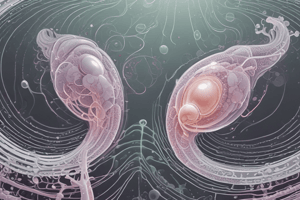Podcast
Questions and Answers
What is the purpose of mitotic proliferation of spermatogonia?
What is the purpose of mitotic proliferation of spermatogonia?
- To form secondary spermatocytes
- To remodel spermatids
- To provide a continual supply of new germ cells (correct)
- To transport sperm towards the lumen
What happens to one daughter cell during mitotic proliferation of spermatogonia?
What happens to one daughter cell during mitotic proliferation of spermatogonia?
- It remains undifferentiated (correct)
- It becomes a spermatozoon
- It undergoes meiosis
- It forms secondary spermatocytes
What is the result of meiosis in spermatogenesis?
What is the result of meiosis in spermatogenesis?
- Formation of haploid spermatids (correct)
- Formation of secondary spermatocytes
- Mitotic division of spermatogonia
- Remodeling of cell elements
What is the final product of spermiogenesis?
What is the final product of spermiogenesis?
What is the purpose of sperm cells?
What is the purpose of sperm cells?
Is spermatogenesis always 100% efficient?
Is spermatogenesis always 100% efficient?
How many chromosomes do daughter cells have after mitotic division of spermatogonia?
How many chromosomes do daughter cells have after mitotic division of spermatogonia?
What is the purpose of primary spermatocytes undergoing meiosis?
What is the purpose of primary spermatocytes undergoing meiosis?
What is the process of remodeling spermatids into spermatozoa called?
What is the process of remodeling spermatids into spermatozoa called?
What is the chromosome count of haploid spermatids?
What is the chromosome count of haploid spermatids?
What is the purpose of one daughter cell remaining undifferentiated during mitotic proliferation of spermatogonia?
What is the purpose of one daughter cell remaining undifferentiated during mitotic proliferation of spermatogonia?
What happens to primary spermatocytes during meiosis?
What happens to primary spermatocytes during meiosis?
Flashcards are hidden until you start studying
Study Notes
- Mitotic proliferation of spermatogonia provides a continual supply of new germ cells
- One daughter cell remains undifferentiated while the other moves towards the lumen to form sperm
- Primary spermatocytes undergo meiosis to form secondary spermatocytes and finally yield four spermatids
- Each spermatid is remodeled into a single spermatozoon through spermiogenesis
- Sperm are specialized, mobile cells that contain only the essentials for fertilization
- Spermatogenesis is not always 100% efficient and some cells are lost at various stages
- Mitotic division of spermatogonia results in daughter cells with 46 chromosomes
- Meiosis results in haploid spermatids with 23 single chromosomes
- Sperm travel lightly and only carry essentials for fertilization
- The process of spermiogenesis involves extensive remodeling of cell elements.
Studying That Suits You
Use AI to generate personalized quizzes and flashcards to suit your learning preferences.




